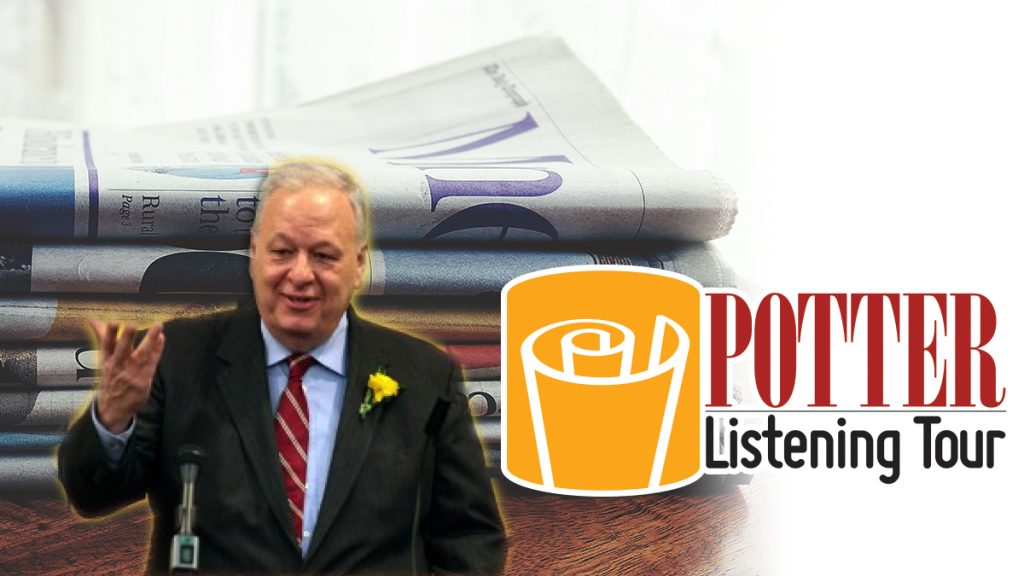
A new ‘Potter Listening Tour:’ Local newspapers can still work, even with different paths
A different kind of “right sizing,” grants and donations, and tinkering with the balance of online and print are some of the ways
Helping small newspapers is in Potter’s DNA: In 2010, the Missouri School of Journalism alumnus established the Walter B. Potter Fund for Innovation in Local Journalism — named after his father, a longtime community newspaper publisher — at his alma mater. The Potter Fund initially sponsored a series of conferences on new newspaper technology. Currently the fund backs the Potter Digital Ambassadors, which sends Missouri journalism students out to local papers as consultants on new technology, a request generated by the initial Potter Listening Tour.
Emerging trends in local news business models may be cause for optimism about local news coverage.
One advance finds newspaper owners creating small regional groups that hit the sweet spot where both economies of scale and the advantages of local ownership can be achieved. The other evolution is the proliferating ways news organizations are leveraging donations to support their local news coverage.
I examined these developments while visiting small newspapers in Missouri and Virginia this past fall as part of my continuing work with the University of Missouri School of Journalism’s Donald W. Reynolds Journalism Institute.
I also found papers that continue to prosper in particular markets with more traditional approaches. The St. Louis American is doing better than ever as it fine tunes coverage of its metro area’s African American community. The News-Gazette in the Valley of Virginia relies on familiar revenue sources like developing publications for local businesses.
This project updates visits made in 2015 and 2016 — dubbed the Potter Listening Tours — to nine traditional community news organizations and one Hispanic publication. I reported on the companies’ initial efforts to meet challenges the Internet poses to revenues and news coverage.
Six years later, small newspapers have developed new techniques for a digital age.
Trips to Westplex Media Group and Leader Publications showed a “right sizing” strategy yielding positive results. These two groups have four newspapers each, which provide opportunities for cost sharing. Meanwhile, the ownership and management of these newspapers know the communities their papers cover intimately.
Both Westplex Media Owner Tim Schmidt and Leader Publisher Peggy Scott grew up in the same areas where their papers are published. “Our advantage is we live here,” Schmidt says. “My name is on it.”
Schmidt acquired two of his papers from Gannett Co. that the giant corporation felt didn’t fit the model for its nearly 1,000 papers nationwide but Schmidt felt were well-suited for his operation in the western suburbs of St. Louis. Meanwhile, Leader Publications has been matching its growth to the expansion of communities in the southern St. Louis suburbs.
Emerging trends in local news business models may be cause for optimism about local news coverage. One advance finds newspaper owners creating small regional groups that hit the sweet spot where both economies of scale and the advantages of local ownership can be achieved. The other evolution is the proliferating ways news organizations are leveraging donations to support their local news coverage.
This version of “right sizing,” it should be noted, differs from the usual usage of the term as a euphemism for layoffs. Both companies have added employees recently — Schmidt has doubled his staff in four years — and are actively searching for more.
Trips to The Kansas City Beacon and The Northeast News of Kansas City showed two different approaches to relying on grants and donations for revenue. The Beacon is a brand new news organization that publishes entirely on line and brings new ideas to government reporting and community engagement. The Northeast News is a 90-year-old small community paper that distributes in both print and digital while trying to blend grants and donations with its traditional advertising income.
The Beacon is trying not only to reshape the news and funding models for local news coverage, but even how employees interact with each other.. “We don’t lack for new ideas,” says Publisher Jennifer Hack Wolf as she recounted the extensive research that went into founding the Beacon in 2020. Those innovations range from the structure of news meetings to the office-as-a-service Midtown Kansas City “Plexpod” where they have their offices. The Beacon pursues a heavy emphasis on community engagement using advisory boards, events to meet the public and attention to web site analytics.
Funding the Beacon’s activities relies nearly entirely on donations. “It’s very much a public broadcasting model,” says Chelan David, vice president of development, who adds the company’s aim is to achieve sustainability.
In contrast, The Northeast News, nestled in its namesake Kansas City neighborhood just south of the Missouri River, still puts out a print version as it has since 1932. The free distribution paper continues to take in revenue through advertising, but last May it began operating as a non-profit corporation. This allows the organization to seek grant and foundation funding set aside for non-profit journalism outlets as well as discounts on supplies and even sales tax, says Publisher Michael Bushnell. “We want to make us sustainable.”
Non-profit status, though, is not for the faint-hearted, says Bushnell, who gave a presentation on the paperwork-intensive process at last fall’s Missouri Press Association convention. Schmdit and Scott joined a number of other publishers curious about Bushnell’s venture.
Like its suburban St. Louis brethren, the St. Louis American found that right sizing was the right move. “During the pandemic we had to cut back on distribution, saving money” says Chief Operating Officer Kevin Jones, “but people still found the (free distribution) paper.” Meanwhile, revenues picked up as corporations wanted more than ever to reach the American’s loyal African American readers. The result? 2021 was the 94-year-old publication’s best year and 2022 was the second best.
The American cut costs, but not people, maintaining its staff. That was reflected in the paper’s performance. Its web site reports that over the past three years, the St. Louis American has “received nearly 100 local, regional, and national awards for excellence in journalism and design, advertising and community service.”
The News-Gazette of Lexington, Va., decades into the Internet Age, is sustaining its place as Rockbridge County’s local news source by doing the fundamental things papers have done for years. The News-Gazette has a website with a fairly strict paywall, says Fourth Generation Owner Matt Paxton, but he points with pride to multiple publications his company prints for local businesses.
I’ll go into more detail on these fall visits in future posts.

Comments